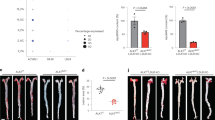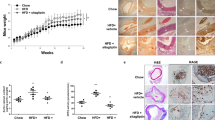Abstract
Accelerated atherosclerosis in patients with diabetes is a major cause of their morbidity and mortality, and it is unresponsive to therapy aimed at restoring relative euglycemia. In hyperglycemia, nonenzymatic glycation and oxidation of proteins and lipids results in the accumulation of irreversibly formed advanced glycation endproducts. These advanced glycation endproducts engage their receptor in cells of the blood vessel wall, thereby activating mechanisms linked to the development of vascular lesions. We report here a model of accelerated and advanced atherosclerosis in diabetic mice deficient for apolipoprotein E. Treatment of these mice with the soluble extracellular domain of the receptor for advanced glycation endproducts completely suppressed diabetic atherosclerosis in a glycemia- and lipid-independent manner. These findings indicate interaction between the advanced glycation endproducts and their receptor is involved in the development of accelerated atherosclerosis in diabetes, and identify this receptor as a new therapeutic target in diabetic macrovascular disease.
This is a preview of subscription content, access via your institution
Access options
Subscribe to this journal
Receive 12 print issues and online access
$209.00 per year
only $17.42 per issue
Buy this article
- Purchase on SpringerLink
- Instant access to full article PDF
Prices may be subject to local taxes which are calculated during checkout




Similar content being viewed by others
References
Uusitupa, M.I., Niskanen, L.K., Siitonen, O., Voutilainen, E. & Pyorala, K. Five-year incidence of atherosclerotic vascular disease in relation to general risk factors, insulin level, and abnormalities in lipoprotein composition in non-insulin-dependent diabetic and non-diabetic subjects. Circulation 82, 27– 36 (1990).
Manson, J.E. et al. A prospective study of maturity-onset diabetes mellitus and risk of coronary heart disease and stroke in women. Arch. Intern. Med. 151, 1141–1147 ( 1991).
Kannel, W.B., & McGee, D.L. Diabetes and cardiovascular disease: The Framingham Study. J. Am. Med. Assoc. 241, 2035–2038 (1979).
The Diabetes Control and Complications Trial Research Group. The effect of intensive treatment of diabetes on the development and progression of long-term complications in insulin-dependent diabetes mellitus. N. Engl. J. Med. 329, 977– 986 (1993).
Ruderman, N., Williamson. J. & Brownlee, M. Glucose and diabetic vascular disease. FASEB J 6, 2905–2914 ( 1992).
Brownlee, M., Cerami, A. & Vlassara, H. Advanced glycosylation end products in tissue and the biochemical basis of diabetic complications. N. Engl. J. Med. 318, 1315–1320 (1988).
Schmidt, A.M. et al. Isolation and characterization of binding proteins for advanced glycosylation endproducts from lung tissue which are present on the endothelial cell surface. J. Biol. Chem. 267, 14987– 14997 (1992).
Neeper, M. et al. Cloning and expression of RAGE: a cell surface receptor for advanced glycosylation end products of proteins. J. Biol. Chem. 267, 14998–15004 (1992).
Wautier, J-L. et al. Advanced glycation endproducts (AGEs) on the surface of diabetic red cells bind to the vessel wall via a specific receptor inducing oxidant stress in the vasculature: a link between surface-associated AGEs and diabetic complications. Proc. Natl. Acad. Sci. USA 91, 7742–7746 (1994).
Schmidt, A-M. et al. Advanced glycation endproducts interacting with their endothelial receptor induce expression of vascular cell adhesion molecule-1 (VCAM-1): a potential mechanism for the accelerated vasculopathy of diabetes. J. Clin. Invest. 96, 1395–1403 (1995).
Miyata, T. et al. The Receptor for Advanced Glycation Endproducts (RAGE) mediates the interaction of AGE-ß2-Microglobulin with human mononuclear phagocytes via an oxidant-sensitive pathway: implications for the pathogenesis of dialysis-related amyloidosis. J. Clin. Invest. 98 , 1088–1094 (1996).
Schmidt, A.M. et al. The receptor for Advanced Glycation Endproducts (AGEs) has a central role in vessel wall interactions and gene activation in response to AGEs in the intravascular space. Proc. Natl. Acad. Sci. USA 91, 8807–8811 ( 1994).
Wautier, J-L. et al. Receptor-mediated endothelial cell dysfunction in diabetic vasculopathy: soluble receptor for advanced glycation endproducts blocks hyperpermeability. J. Clin. Invest. 97, 238– 243 (1996).
Nishina, P.M., Verstufyt, J. & Paigen, B. Synthetic low and high fat diets for the study of atherosclerosis in the mouse. J. Lipid. Res. 31, 859– 869 (1990).
Kunjathoor, V.V., Wilson, D.L. & LeBoeuf, R.C. Increased atherosclerosis in streptozotocin-induced diabetic mice. J. Clin. Invest. 97, 1767 –1773 (1996).
Zhang, S., Reddick, R.L., Piedrahita, J.A. & Maeda, N. Spontaneous hypercholesterolemia and arterial lesions in mice lacking apolipoprotein E. Science 258, 468–471 (1992).
Plump, A.S. et al. Severe hypercholesterolemia and atherosclerosis in apolipoprotein E-deficient mice created by homologous recombination in ES cells. Cell 71, 343–353 ( 1992).
Like, A.A. & Rossini A.A. Streptozotocin-induced pancreatic insulitis: new model of diabetes mellitus. Science 193, 415–417 (1976).
Dahlquist, G. et al. Metabolic control in 131 juvenile-onset diabetic patients as measured by HbA1c: relation to age, duration, C-peptide, insulin dose, and one or two insulin injections. Diabetes Care 5, 399–403 (1982).
Nakashima, Y., Plump, A.S., Raines, E.W., Breslow, J.L. & Ross, R. Apo E-deficient mice develop lesions of all phases of atherosclerosis throughout the arterial tree. Arterioscler Thromb 141, 133–140 (1994).
Paigen, B., Morrow, A., Holmes, P.A., Mitchell, D. & Williams, R.A. Quantitative assessment of atherosclerotic lesions in mice. Atherosclerosis 68, 231– 240 (1987).
Schmidt, A.M., Yan, S.D. & Stern, D. The Dark Side of Glucose. Nature Medicine 1, 1002–1004 (1995).
Palinski, W. Immunological evidence for the presence of advanced glycosylation end products in atherosclerotic lesions of euglycemic rabbits. Arterioscler. Thromb. Vasc. Biol. 15, 571–582 (1995).
Palinski, W. et al. ApoE-deficient mice are a model of lipoprotein oxidation in atherogenesis. Demonstration of oxidation-specific epitopes in lesions and high titers of autoantibodies to malondialdehyde-lysine in serum. Arterioscler. Thromb. 14, 605–616 (1994).
Gown, A.M., Tsukada, T. & Ross, R. Human atherosclerosis: II. Immunocytochemical analysis of the cellular composition of human atherosclerotic lesions. Am. J. Pathol. 125: 191–207 (1986).
Yan, S-D. et al. Enhanced cellular oxidant stress by the interaction of advanced glycation endproducts with their receptors/binding proteins. J. Biol. Chem. 269, 9889–9897 (1994).
Lander, H.L., Tauras, J.M., Ogiste, J.S., Moss, R.A. & Schmidt, A.M. Activation of the Receptor for Advanced Glycation Endproducts triggers a MAP Kinase pathway regulated by oxidant stress. J. Biol. Chem. 272, 17810 –17814 (1997).
Morel, D.W. & Chisolm, G.M. Antioxidant treatment of diabetic rats inhibits lipoprotein oxidation and cytotoxicity. J. Lipid Res. 30, 1827–1834 ( 1989).
Berliner, J.A. & Heinecke, J.W. The role of oxidized lipoproteins in atherogenesis. Free Radic. Biol. Med. 20, 707–727 (1996).
Wilson, P.W.F., Cupples L.A. & Kannel, W.B. Is hyperglycemia associated with cardiovascular disease? The Framingham study. Am. Heart J. 121, 586–590 (1991).
Jarrett, R.J. The cardiovascular risk associated with impaired glucose tolerance. Diabet. Med. 13 (3 Suppl 2), S15–19 (1996).
Suzuki, H. et al. A role for macrophage scavenger receptors in atherosclerosis and susceptibility to infection. Nature 386, 292–296 (1997).
Li, Y.M. et al. Molecular identity and cellular distribution of advanced glycation endproduct receptors: relationship of p60 to OST-48 and p90 to 80K-H membrane proteins. Proc. Natl. Acad. Sci. USA 93, 11047–11052 (1996).
Havel, R.J., Eder, H.A. & Bragdon, J.H. The distribution and chemical composition of ultracentrifugally separated lipoproteins in human serum. J. Clin. Invest. 34, 1345–1353 (1995).
Esterbauer, H., Gebicki, J., Puhl, H. & Jurgens, G. The role of lipid peroxidation and antioxidants in oxidative modification of LDL. Free Radic. Biol. Med. 13, 341–390 (1992).
Tangirala, R.K. et al. Effect of the antioxidant N,N'-Diphenyl 1,4-Phenylenediamine (DPPD) on atherosclerosis in ApoE-deficient mice. Arterioscler. Thromb. Vasc. Biol. 15, 1625–1630 (1995).
Acknowledgements
The authors acknowledge the advice and assistance of N. Maeda, E. Rubin, C. Fu, W. Qu, J. Verstuyft, S. Drury and E. Bernstein. We thank M. Prescott, G. Andres and G.C. Godman for their suggestions and review of the histology. This work was supported by grants from the USPHS (AG00602, DK52495 and HL 56881), the American Heart Association, New York City affiliate, the Council for Tobacco Research, the Juvenile Diabetes Foundation and the Surgical Research Fund.
Author information
Authors and Affiliations
Corresponding author
Rights and permissions
About this article
Cite this article
Park, L., Raman, K., Lee, K. et al. Suppression of accelerated diabetic atherosclerosis by the soluble receptor for advanced glycation endproducts. Nat Med 4, 1025–1031 (1998). https://doi.org/10.1038/2012
Received:
Accepted:
Issue Date:
DOI: https://doi.org/10.1038/2012



